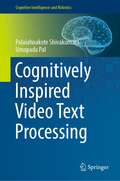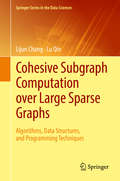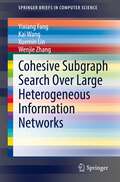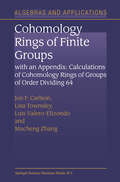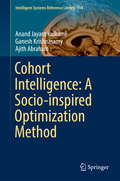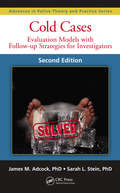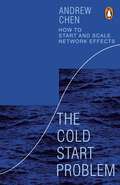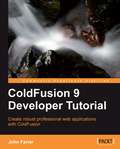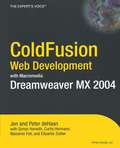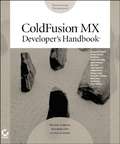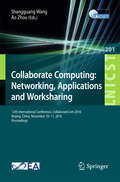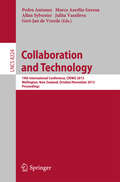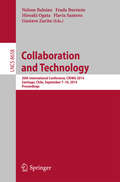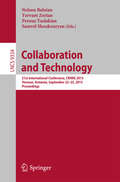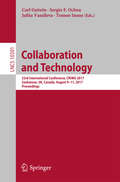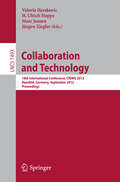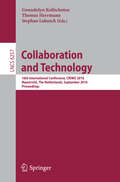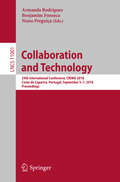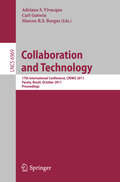- Table View
- List View
Cognitively Inspired Video Text Processing (Cognitive Intelligence and Robotics)
by Umapada Pal Palaiahnakote ShivakumaraAs technologies are fast advancing, the importance of text detection and recognition is receiving special attention from the researchers. Thus, one can see several real-time applications of video text processing which requires cognitive-based methods to find a solution. The main applications are (1) retrieving and indexing video based on semantic of the content of the video, (2) machine translation to assist foreigners, (3) assisting blind people to walk on the road freely without aid, (4) automatic vehicle driving, (5) license plate tracing to catch vehicles which violate the traffic signals, (6) monitoring the images posted on social media based on text and content of the images, (7) identifying the location based on the address of the street and shops, etc., (8) tracing players in the sports based on the jersey/bib number or text, and (9) in the same way, tracing the bib number in case of marathon and other events. For the above-mentioned applications, text detection and recognition in video and natural scene images is an integral part of the system.
Coherence: In Signal Processing and Machine Learning
by David Ramírez Ignacio Santamaría Louis ScharfThis book organizes principles and methods of signal processing and machine learning into the framework of coherence. The book contains a wealth of classical and modern methods of inference, some reported here for the first time. General results are applied to problems in communications, cognitive radio, passive and active radar and sonar, multi-sensor array processing, spectrum analysis, hyperspectral imaging, subspace clustering, and related. The reader will find new results for model fitting; for dimension reduction in models and ambient spaces; for detection, estimation, and space-time series analysis; for subspace averaging; and for uncertainty quantification. Throughout, the transformation invariances of statistics are clarified, geometries are illuminated, and null distributions are given where tractable. Stochastic representations are emphasized, as these are central to Monte Carlo simulations. The appendices contain a comprehensive account of matrix theory, the SVD, the multivariate normal distribution, and many of the important distributions for coherence statistics. The book begins with a review of classical results in the physical and engineering sciences where coherence plays a fundamental role. Then least squares theory and the theory of minimum mean-squared error estimation are developed, with special attention paid to statistics that may be interpreted as coherence statistics. A chapter on classical hypothesis tests for covariance structure introduces the next three chapters on matched and adaptive subspace detectors. These detectors are derived from likelihood reasoning, but it is their geometries and invariances that qualify them as coherence statistics. A chapter on independence testing in space-time data sets leads to a definition of broadband coherence, and contains novel applications to cognitive radio and the analysis of cyclostationarity. The chapter on subspace averaging reviews basic results and derives an order-fitting rule for determining the dimension of an average subspace. These results are used to enumerate sources of acoustic and electromagnetic radiation and to cluster subspaces into similarity classes. The chapter on performance bounds and uncertainty quantification emphasizes the geometry of the Cramèr-Rao bound and its related information geometry.
Coherent Atomic Manipulation and Cooling: Interferometric Laser Cooling and Composite Pulses for Atom Interferometry (Springer Theses)
by Alexander J. DunningThis work unites the concepts of laser cooling and matter-wave interferometry to develop an interferometric laser cooling technique in an experimental system of cold rubidium atoms. Serving as an introduction to graduate level coherent optical atomic manipulation, the thesis describes the theory of stimulated Raman transitions and atom interferometry, along with the experimental methods for preparing and manipulating cold atoms, before building on these foundations to explore tailored optical pulse sequences and novel atomic cooling techniques.Interferometric cooling, originally proposed by Weitz and Hänsch in 2000, is based upon the coherent broadband laser pulses of Ramsey interferometry and in principle allows laser cooling of atomic and molecular species outside the scope of traditional Doppler laser cooling. On the path toward cooling, composite pulses – quantum error correction methods, developed by chemists to mitigate the effects of in homogeneities in NMR spectroscopy – are investigated with a view to improving the performance of atom interferometers.
Coherent Evolution in Noisy Environments (Lecture Notes in Physics #611)
by Andreas Buchleitner Klaus HornbergerIn the last two decades extraordinary progress in the experimental handling of single quantum objects has spurred theoretical research into investigating the coupling between quantum systems and their environment. Decoherence, the gradual deterioration of entanglement due to dissipation and noise fed to the system by the environment, has emerged as a central concept. The present set of lectures is intended as a high-level, but self-contained, introduction into the fields of quantum noise and dissipation.In particular their influence on decoherence and applications pertaining to quantum information and quantum communication are studied, leading the nonspecialist researchers and the advanced students gradually to the forefront of research.
Coherent States, Wavelets and Their Generalizations (Graduate Texts in Contemporary Physics)
by Syed T. Ali J-P Antoine Jean-Perre GazeauA survey of the theory of coherent states, wavelets, and some of their generalizations, emphasizing mathematical structures. Starting from the standard theory of coherent states over Lie groups, the authors generalize the formalism by associating coherent states to group representations that are square integrable over a homogeneous space; a further step allows the group context to be dispensed with altogether. The unified background makes transparent otherwise obscure properties of wavelets and of coherent states. Many concrete examples, such as semisimple Lie groups, the relativity group, and several kinds of wavelets, are discussed in detail. The book concludes with physical applications, centering on the quantum measurement problem and the quantum-classical transition. Intended as an introduction to current research for graduate students and others entering the field, the mathematical discussion is self- contained. With its extensive references to the research literature, the book will also be a useful compendium of recent results for physicists and mathematicians already active in the field.
Coherent States, Wavelets, and Their Generalizations (Theoretical and Mathematical Physics)
by Syed Twareque Ali Jean-Pierre Antoine Jean-Pierre GazeauThis second edition is fully updated, covering in particular new types of coherent states (the so-called Gazeau-Klauder coherent states, nonlinear coherent states, squeezed states, as used now routinely in quantum optics) and various generalizations of wavelets (wavelets on manifolds, curvelets, shearlets, etc.). In addition, it contains a new chapter on coherent state quantization and the related probabilistic aspects. As a survey of the theory of coherent states, wavelets, and some of their generalizations, it emphasizes mathematical principles, subsuming the theories of both wavelets and coherent states into a single analytic structure. The approach allows the user to take a classical-like view of quantum states in physics.Starting from the standard theory of coherent states over Lie groups, the authors generalize the formalism by associating coherent states to group representations that are square integrable over a homogeneous space; a further step allows one to dispense with the group context altogether. In this context, wavelets can be generated from coherent states of the affine group of the real line, and higher-dimensional wavelets arise from coherent states of other groups. The unified background makes transparent an entire range of properties of wavelets and coherent states. Many concrete examples, such as coherent states from semisimple Lie groups, Gazeau-Klauder coherent states, coherent states for the relativity groups, and several kinds of wavelets, are discussed in detail. The book concludes with a palette of potential applications, from the quantum physically oriented, like the quantum-classical transition or the construction of adequate states in quantum information, to the most innovative techniques to be used in data processing.Intended as an introduction to current research for graduate students and others entering the field, the mathematical discussion is self-contained. With its extensive references to the research literature, the first edition of the book is already a proven compendium for physicists and mathematicians active in the field, and with full coverage of the latest theory and results the revised second edition is even more valuable.
Coherent Structures in Complex Systems: Selected Papers of the XVII Sitges Conference on Statistical Mechanics Held at Sitges, Barcelona, Spain, 5–9 June 2000. Preliminary Version (Lecture Notes in Physics #567)
by D. Reguera L. L. Bonilla J. M. RubiA rich variety of real-life physical problems which are still poorly understood are of a nonlinear nature. Examples include turbulence, granular flows, detonations and flame propagation, fracture dynamics, and a wealth of new biological and chemical phenomena which are being discovered. Particularly interesting among the manifestations of nonlinearity are coherent structures. This book contains reviews and contributions reporting on the state of the art regarding the role of coherent structures and patterns in nonlinear science.
Cohesive Subgraph Computation over Large Sparse Graphs: Algorithms, Data Structures, and Programming Techniques (Springer Series in the Data Sciences)
by Lijun Chang Lu QinThis book is considered the first extended survey on algorithms and techniques for efficient cohesive subgraph computation. With rapid development of information technology, huge volumes of graph data are accumulated. An availability of rich graph data not only brings great opportunities for realizing big values of data to serve key applications, but also brings great challenges in computation. Using a consistent terminology, the book gives an excellent introduction to the models and algorithms for the problem of cohesive subgraph computation. The materials of this book are well organized from introductory content to more advanced topics while also providing well-designed source codes for most algorithms described in the book. This is a timely book for researchers who are interested in this topic and efficient data structure design for large sparse graph processing. It is also a guideline book for new researchers to get to know the area of cohesive subgraph computation.
Cohesive Subgraph Search Over Large Heterogeneous Information Networks (SpringerBriefs in Computer Science)
by Wenjie Zhang Xuemin Lin Kai Wang Yixiang FangThis SpringerBrief provides the first systematic review of the existing works of cohesive subgraph search (CSS) over large heterogeneous information networks (HINs). It also covers the research breakthroughs of this area, including models, algorithms and comparison studies in recent years. This SpringerBrief offers a list of promising future research directions of performing CSS over large HINs.The authors first classify the existing works of CSS over HINs according to the classic cohesiveness metrics such as core, truss, clique, connectivity, density, etc., and then extensively review the specific models and their corresponding search solutions in each group. Note that since the bipartite network is a special case of HINs, all the models developed for general HINs can be directly applied to bipartite networks, but the models customized for bipartite networks may not be easily extended for other general HINs due to their restricted settings. The authors also analyze and compare these cohesive subgraph models (CSMs) and solutions systematically. Specifically, the authors compare different groups of CSMs and analyze both their similarities and differences, from multiple perspectives such as cohesiveness constraints, shared properties, and computational efficiency. Then, for the CSMs in each group, the authors further analyze and compare their model properties and high-level algorithm ideas.This SpringerBrief targets researchers, professors, engineers and graduate students, who are working in the areas of graph data management and graph mining. Undergraduate students who are majoring in computer science, databases, data and knowledge engineering, and data science will also want to read this SpringerBrief.
Cohomology Rings of Finite Groups: With an Appendix: Calculations of Cohomology Rings of Groups of Order Dividing 64 (Algebra and Applications #3)
by Jon F. Carlson L. Townsley Luís Valero-Elizondo Mucheng ZhangGroup cohomology has a rich history that goes back a century or more. Its origins are rooted in investigations of group theory and num ber theory, and it grew into an integral component of algebraic topology. In the last thirty years, group cohomology has developed a powerful con nection with finite group representations. Unlike the early applications which were primarily concerned with cohomology in low degrees, the in teractions with representation theory involve cohomology rings and the geometry of spectra over these rings. It is this connection to represen tation theory that we take as our primary motivation for this book. The book consists of two separate pieces. Chronologically, the first part was the computer calculations of the mod-2 cohomology rings of the groups whose orders divide 64. The ideas and the programs for the calculations were developed over the last 10 years. Several new features were added over the course of that time. We had originally planned to include only a brief introduction to the calculations. However, we were persuaded to produce a more substantial text that would include in greater detail the concepts that are the subject of the calculations and are the source of some of the motivating conjectures for the com putations. We have gathered together many of the results and ideas that are the focus of the calculations from throughout the mathematical literature.
Cohort Intelligence: A Socio-inspired Optimization Method (Intelligent Systems Reference Library #114)
by Anand Jayant Kulkarni Ganesh Krishnasamy Ajith AbrahamThis Volume discusses the underlying principles and analysis of the different concepts associated with an emerging socio-inspired optimization tool referred to as Cohort Intelligence (CI). CI algorithms have been coded in Matlab and are freely available from the link provided inside the book. The book demonstrates the ability of CI methodology for solving combinatorial problems such as Traveling Salesman Problem and Knapsack Problem in addition to real world applications from the healthcare, inventory, supply chain optimization and Cross-Border transportation. The inherent ability of handling constraints based on probability distribution is also revealed and proved using these problems.
Cold Cases: Evaluation Models with Follow-up Strategies for Investigators, Second Edition
by James M. Adcock Sarah L. SteinBecause the investigation of cold cases is usually an arduous and time-consuming task, most law enforcement agencies in the United States are not able to dedicate the resources necessary to support the cold case investigation process. However, when those cases are fully pursued and prosecuted, they often result in convictions and lengthy prison ter
The Cold Start Problem: Using Network Effects to Scale Your Product
by Andrew ChenA transformative guide to growing any business, from one of Silicon Valley's most esteemed investorsFinancial Times Business Book of the Month'A true Silicon Valley insider' WiredWhy do some products take off? And what can we learn from them?The hardest part of launching a product is getting started. When you have just an idea and a handful of customers, growth can feel impossible. This is the cold start problem.Andrew Chen has a solution. As a partner at the pre-eminent VC firm Andreesen Horowitz, he has invested in some of the world's fastest-growing companies. Along the way, he's become one of the most renowned bloggers in tech - hailed by Wired as a 'true Silicon Valley insider'.Now, Chen reveals how any organisation can surmount the cold start problem. His solution lies in the network effect: the way a service improves as more people sign up. It means that today's leading products - from Wikipedia to to WhatsApp - get more powerful with every additional user.Drawing on interviews with the founders of LinkedIn, Zoom, Uber, Dropbox, Tinder, Airbnb and more, Chen unpicks how to start and scale these network effects. He reveals how to build an 'atomic network' that is just big enough to sustain itself. He uncovers how to spot the tipping point after which growth takes care of itself. And he explores why some big companies manage to sustain viral network effects for years (while others quickly stop growing). The result is a one-stop guide to scaling a product, road-tested at some of the world's most valuable companies. Praise for Andrew Chen'Andrew's blog is an inexhaustible source of numbers and ideas on concepts that matter' Max Levchin, co-founder of PayPal'Here's one message you want. Chen's weekly newsletter offers thoughtful essays on startups and marketing' Wired'One of the best entrepreneurship blogs of all time' Eric Ries, author of The Lean Startup
ColdFusion 9 Developer Tutorial
by John FarrarThis book is a fast-paced tutorial to developing ColdFusion applications, with an emphasis on real-world skills. Packed with examples and careful explanations, the book leads you through all the topics relevant to today's ColdFusion developer. This book is for web developers working with ColdFusion 9. If your goal is to get a good grounding in the basics of the language as quickly as possible and put a site together quickly, this book is ideal for you. This book will also help you if you want to learn more about professional programming of ColdFusion. No prior knowledge of ColdFusion is expected, but basic knowledge of general web and software development skills is assumed.
ColdFusion Web Development with Macromedia Dreamweaver MX 2004
by Peter de Haan Curtis Hermann Simon Horwith Edoardo Zubler Massimo Foti* Competitively priced, comprehensively illustrated, with in-depth "real world" applied content. There are only 2 other books that approach this subject matter, and our book is more concise, practical, and reaches a more advanced level that than the others. All source code for examples and case study will be openly available for download from www.apress.com. * In-depth final case study – in the final chapter we explore the planning, design, and implementation of an entire fully working website, using all of the code, concepts, and techniques learnt in earlier chapters. This highly applied look at integrating ColdFusion and Dreamweaver in a complete project unifies all of the concepts learnt and takes our book above and beyond the competitors, which rely heavily on theory and small isolated examples. * The authors (in Particular Jen deHaan, Massimo Foti and Simon Horwith) are highly experienced and renowned members of the Dreamweaver and ColdFusion web communities.
ColdFusion MX Developer's Handbook
by Raymond Camden Arman Danesh Hal Helms Guy Rish Emily Kim Shlomy Gantz Jen deHaan Peter deHaan Charles Mohnike Selene Bainum John Colasante William Baum Kenneth N. Fricklas Matt LiottaColdFusion is an extremely powerful web-development tool. Despite its short initial learning curve, attributed to its accessible HTML-like, tag-based syntax, it provides sophisticated content-management solutions for large-scale enterprises. This has never been truer than it is now, since the release of ColdFusion MX. To take advantage of this power, you must step outside the box to learn skills as diverse as application design and Web Services development--topics addressed only briefly, if at all, in standard ColdFusion tutorials and reference books. ColdFusion MX Developer's Handbook teaches you what you need to broaden your ColdFusion skills and become a fully capable enterprise developer. Inside, 13 ColdFusion experts provide highly detailed, advanced instruction that will save you countless headaches and let you squeeze every last drop of functionality from the newest release. You'll master database integration techniques involving advanced SQL queries, stored procedures, and database upsizing. You'll take advantage of MX's improved integration with other technologies, incorporating Flash using Flash Remoting, and capitalizing on full XML support to create Web Services. In your custom coding, you'll build and deploy Java and C++ extensions and wirelessly extend ColdFusion's reach with components that talk to WAP and WML clients. All this comes wrapped in practical, hard-to-find advice for managing your content and applications and optimizing performance. Large applications with heavy traffic need speed and efficiency, and you get that with performance turning, load balancing, and caching. If you're working in a clustered environment, you need to understand state management. No matter what your situation, you'll benefit from in-depth coverage of application security, debugging, and coding methodology using Fusebox. Every chapter is packed with the technical knowledge to give you what you need to create serious solutions. You might find that one particular chapter alone is worth the cost of the book because of the time and frustration it will save you. Most readers, however, will use various parts of this book at different times, depending on the constantly changing challenges faced by enterprise programmers. The mission of this book is to provide the extra skills you need to be a successful ColdFusion developer in today's demanding and expanding environment.
Collaborate Computing: 12th International Conference, CollaborateCom 2016, Beijing, China, November 10–11, 2016, Proceedings (Lecture Notes of the Institute for Computer Sciences, Social Informatics and Telecommunications Engineering #201)
by Shangguang Wang Ao ZhouThis book constitutes the thoroughly refereed proceedings of the 12th International Conference on Collaborative Computing: Networking, Applications, and Worksharing, CollaborateCom 2016, held in Beijing, China, in November 2016. The 66 papers presented were carefully reviewed and selected from 116 submissions and focus on topics such as: participatory sensing, crowdsourcing, and citizen science; architectures, protocols, and enabling technologies for collaborative computing networks and systems; autonomic computing and quality of services in collaborative networks, systems, and applications; collaboration in pervasive and cloud computing environments; collaboration in data-intensive scientific discovery; collaboration in social media; big data and spatio-temporal data in collaborative environments/systems; collaboration techniques in data-intensive computing and cloud computing.
Collaboration and Technology: 19th International Conference, CRIWG 2013, Wellington, New Zealand, October 30 - November 1, 2013, Proceedings (Lecture Notes in Computer Science #8224)
by Pedro Antunes Marco Aurélio Gerosa Allan Sylvester Julita Vassileva Gert-Jan De VreedeThis book constitutes the proceedings of the 19th Collaboration Researchers' International Working Group Conference on Collaboration and Technology, held in Wellington, New Zealand, in October/November 2013. The 18 revised papers presented together with 4 progress papers were carefully reviewed and selected from 34 submissions. They are organized into six thematic sessions as follows social media, social networks, crowdsourcing, learning, collaboration design and software development.
Collaboration and Technology: 20th International Conference, CRIWG 2014, Santiago, Chile, September 7-10, 2014, Proceedings (Lecture Notes in Computer Science #8658)
by Nelson Baloian Frada Burstein Hiroaki Ogata Flavia Santoro Gustavo ZuritaThis book constitutes the proceedings of the 20th Collaboration Researchers' International Working Group Conference on Collaboration and Technology, held in Santiago, Chile, in September 2014.The 16 revised papers presented together with 18 progress papers and 3 invited talks were carefully reviewed and selected from 49 submissions. The papers published in proceedings of this year's and past CRIWG conferences reflect the trends in collaborative computing research and its evolution. There was a growing interest in social networks analysis, crowdsourcing and computer support for large communities in general. A special research topic which has been traditionally present in the CRIWG proceedings has been collaborative learning.
Collaboration and Technology: 21st International Conference, CRIWG 2015, Yerevan, Armenia, September 22-25, 2015, Proceedings (Lecture Notes in Computer Science #9334)
by Nelson Baloian Yervant Zorian Perouz Taslakian Samvel ShoukouryanThis book constitutes the refereed proceedings of the 21st International Conference on Collaboration and Technology, CRIWG 2015, held in Yerevan, Armenia, in September 2015.The 19 revised papers presented together with 1 invited talk were carefully reviewed and selected from 28 submissions. CRIWG has been focused on collaboration technology design, development, and evaluation. The background research is influenced by a number of disciplines, such as computer science, management science, informationsystems, engineering, psychology, cognitive sciences, and social sciences.
Collaboration and Technology: 23rd International Conference, CRIWG 2017, Saskatoon, SK, Canada, August 9-11, 2017, Proceedings (Lecture Notes in Computer Science #10391)
by Carl Gutwin Sergio F. Ochoa Julita Vassileva Tomoo InoueThis book constitutes the refereed proceeding of the 23rd International Conference on Collaboration and Technology, CRIWG 2017, held in Saskatoon, Canada, in August 2017. The 14 full papers presented together with 5 work-in-progress papers were carefully reviewed and selected from 33 submissions. The papers focus on collaboration technology design, development, and evaluation. The background research is influenced by a number disciplines, such as computer science, management science, information systems, engineering, psychology, cognitive sciences, and social sciences
Collaboration and Technology: 18th International Conference, CRIWG 2012, Raesfeld, Germany, September 16-19, 2012, Proceedings (Lecture Notes in Computer Science #7493)
by Valeria Herskovic H. Ulrich Hoppe Jürgen Ziegler Marc JansenThis book constitutes the proceedings of the 18th Collaboration Researchers' International Working Group Conference on Collaboration and Technology, held in Raesfeld, Germany, in September 2012. The 9 revised papers presented together with 12 short papers were carefully reviewed and selected from numerous submissions. They are grouped into five themes that represent collaborative learning, social media analytics, conceptual and design models, formal modeling and technical approaches and collaboration support in emergency scenarios.
Collaboration and Technology: 16th International Conference, CRIWG 2010, Maastricht, The Netherlands, September 20-23, 2010, Proceedings (Lecture Notes in Computer Science #6257)
by Gwendolyn Kolfschoten Thomas Herrmann Stephan LukoschThis book constitutes the proceedings of the 16th Collaboration Researchers' International Working Group Conference on Collaboration and Technology, held in Maastricht, The Netherlands, in September 2010.The 27 revised papers presented were carefully reviewed and selected from numerous submissions. They are grouped into seven themes that represent current areas of interest in groupware research: knowledge elicitation, construction and structuring, collaboration and decision making, collaborative development, awareness, support for groupware design, social networking and mobile collaboration.
Collaboration and Technology: 24th International Conference, CRIWG 2018, Costa de Caparica, Portugal, September 5-7, 2018, Proceedings (Lecture Notes in Computer Science #11001)
by Armanda Rodrigues Benjamim Fonseca Nuno PreguiçaThis book constitutes the refereed proceedings of the 24th International Conference on Collaboration and Technology, CRIWG 2018, held in Costa de Caparica, Portugal, in September 2018.The 11 revised full papers presented together with 6 short papers were carefully reviewed and selected from 32 submissions. The papers published in the proceedings of this year span dierent areas of collaborative computing research, from collaborative learning to collaboration through social media and virtual communities.
Collaboration and Technology: 17th International Conference, CRIWG 2011, Paraty, Brazil, October 2-7, 2011, Proceedings (Lecture Notes in Computer Science #6969)
by Adriana S. Vivacqua Carl Gutwin Marcos R. S. BorgesThis book constitutes the proceedings of the 17th Collaboration Researchers' International Working Group Conference on Collaboration and Technology, held in Paraty, Brazil, in October 2011. The 12 revised papers presented together with 6 short papers were carefully reviewed and selected from numerous submissions. They are grouped into four themes that represent current areas of interest in groupware research: theoretical foundation, empirical studies, methods and techniques, and tools for communication and cooperation.
